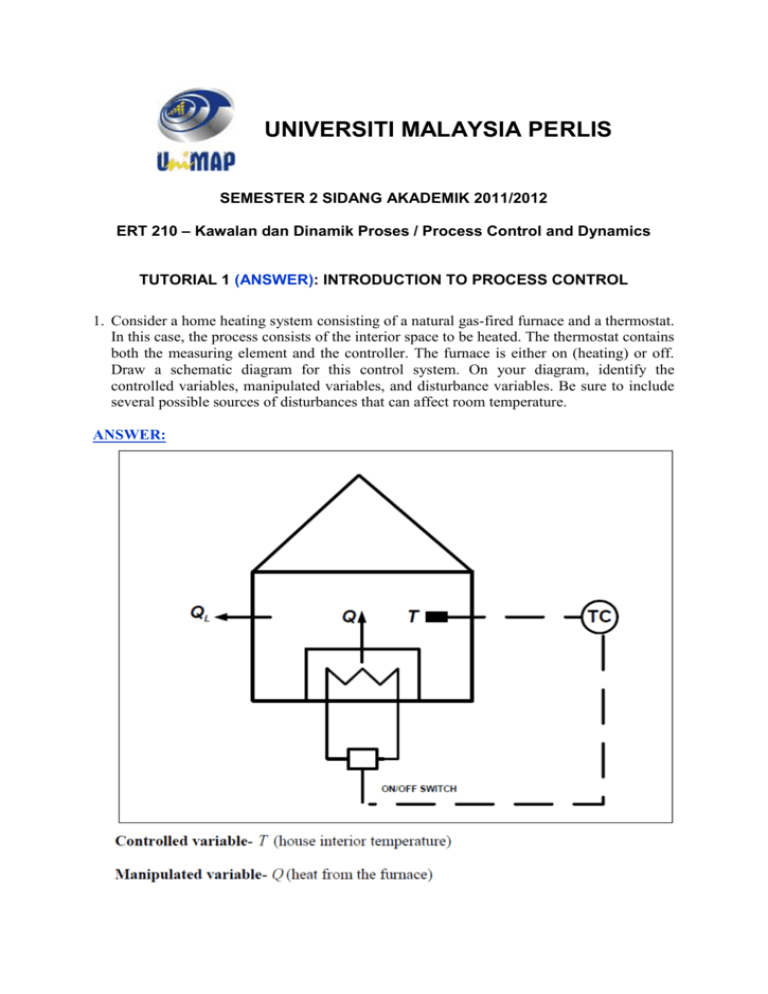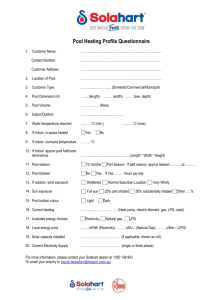UNIVERSITI MALAYSIA PERLIS SEMESTER 2 SIDANG AKADEMIK
advertisement

UNIVERSITI MALAYSIA PERLIS SEMESTER 2 SIDANG AKADEMIK 2011/2012 ERT 210 – Kawalan dan Dinamik Proses / Process Control and Dynamics TUTORIAL 1 (ANSWER): INTRODUCTION TO PROCESS CONTROL 1. Consider a home heating system consisting of a natural gas-fired furnace and a thermostat. In this case, the process consists of the interior space to be heated. The thermostat contains both the measuring element and the controller. The furnace is either on (heating) or off. Draw a schematic diagram for this control system. On your diagram, identify the controlled variables, manipulated variables, and disturbance variables. Be sure to include several possible sources of disturbances that can affect room temperature. ANSWER: 2. I.M. Appelpolsher, supervisor of the process control group of the Ideal gas Company, has installed a 25 x 40 x 25-ft swimming pool in his backyard. The pool contains level and temperature sensors used in feedback controllers to maintain the pool level and temperature at desired values. Appelpolsher is satisfied with the level control system, but he feels that the addition of one or more feedforward controllers would help maintain the temperature more nearly constant. As a new member of the process control group, you have been selected to check Appelpolsher’s mathematical analysis and to give your advice. The following information may not be pertinent to your analysis: (i) Appelpolsher is particular about cleanliness and thus has a high-capacity pump that continually circulates the water through an activated charcoal filter. (ii) The pool is equipped with a natural gas-fired heater that adds heat to the pool at a rate Q(t) that is directly proportional to the output signal from the controller p(t). (iii)There is a leak in the pool, which Appelpolsher has determined is constant equal to F (volumetric flow rate). The liquid-level control adds water from the city supply system to maintain the level in the pool exactly at the specified level. The temperature of the water in the city system is Tw, a variable. (iv) A significant amount of heat is lost by conduction to the surrounding ground, which has a constant, year-round temperature TG. Experimental tests by Appelpolsher showed that essentially all of the temperature loop between the pool and the ground occurred across the homogeneous layer of gravel that surrounded his pool. The gravel thickness is x, and the overall thermal conductivity is kG. (v) The main challenge to Appelpolsher’s modelling ability was the heat loss term accounting for convection, conduction, radiation, and evaporation to the atmosphere. He determined that the heat losses per unit area of open water could be represented by; losses = U(Tp – Ta) where Tp = temperature of pool Ta = temperature of the air, a variable U = overall heat transfer coefficient Appelpolsher’s detailed model included radiation, losses and heat generation due to added chemicals, but he determined that these terms were negligible. (a) Draw a schematic diagram for the pool and all control equipment. Show all inputs and outputs, including all disturbance variables. (b) What additional variable(s) wiuld have to be measured to add feedforward control to the existing pool temperature feedback controller? (c) Write a steady-state energy balance. How can you determine which of the disturbance variables you listed in part (a) are most/least likely to be important? (d) What recommendations concerning the prospects of adding feedforward control would you make to Appelpolsher? ANSWER: (a) Poisoning







